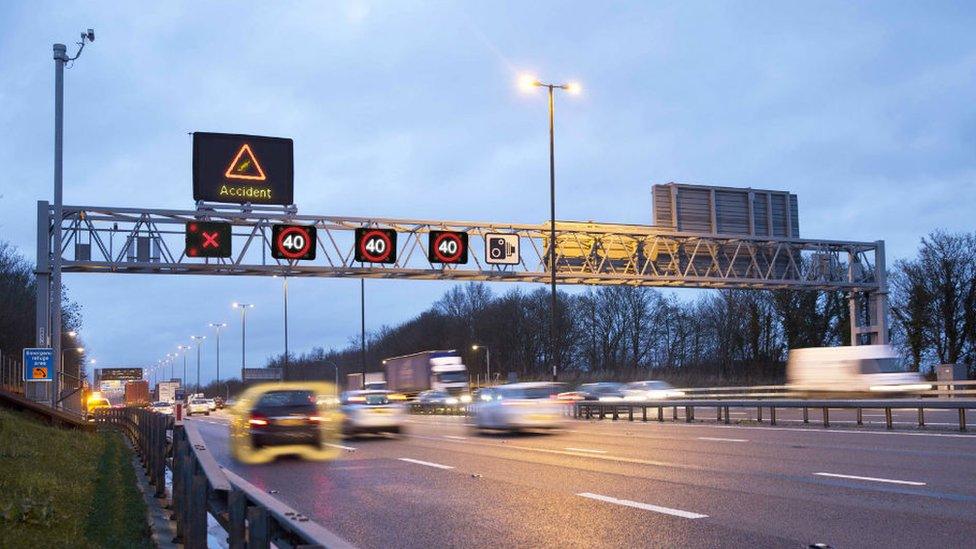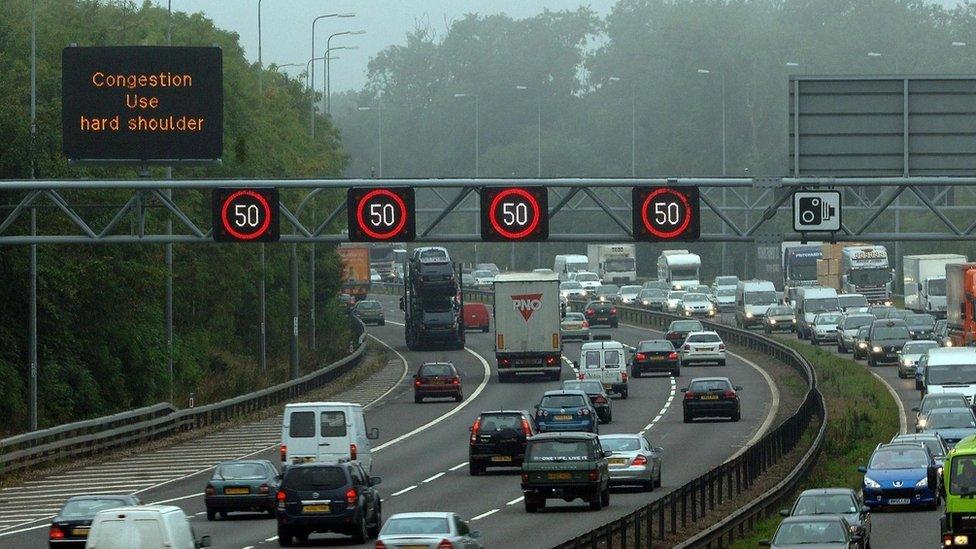Smart motorways plan aims to boost safety
- Published
- comments

The government says it wants to "raise the bar" on smart motorway safety, following criticism of the scheme.
Under the plan, opening motorway hard shoulders for traffic in busy periods will be scrapped.
On those smart motorways where the hard shoulder has been removed entirely, there will be an increase in places for vehicles to stop in an emergency.
Between 2015 and 2018, 11 people a year on average have died on smart motorways in England.
Announcing the plan to improve smart motorway safety, Transport Secretary Grant Shapps said he had been "greatly concerned by a number of deaths on smart motorways, and moved by the accounts of families who've lost loved ones in these tragic incidents".
"The overall evidence shows that in most ways smart motorways are as safe or safer than conventional ones - but they are not in every way," he said.
A Freedom of Information (FoI) request sent by the BBC's Panorama to Highways England revealed that in one section of the M25, outside London, the number of near misses had risen 20-fold since the hard shoulder was removed in April 2014.
In the five years before the road was converted into a smart motorway, there were just 72 near misses. In the five years after, there were 1,485.
Jim O'Sullivan, the chief executive of Highways England, said: "Every death in any road accident is tragic, and we are determined to do all we can to make our roads as safe as possible."
There are two types of smart motorway in the UK.
The first is where the hard shoulder is opened to traffic when it is busy. The second is where the hard shoulder is open all the time and drivers who break down are encouraged to pull into emergency stops.
In addition to abolishing the "confusing" dynamic hard shoulder, the government has said it will also reduce the distance between places to stop in an emergency to three quarters of a mile where possible.
It says this will mean on future schemes, motorists should typically reach a stop every 45 seconds at 60mph. The maximum spacing will be one mile.
The government's plan also includes measures to:
Installing 10 additional emergency areas on the existing M25 smart motorway section
Speeding up the deployment of technology to detect 'stopped vehicles'
Making emergency areas more visible
Introducing more traffic signs giving the distance to the next place to stop in an emergency
Committing £5m to a communications campaign to increase awareness of how smart motorways work
Mr Shapps acknowledged the changes would cost "quite a lot of money", adding it could reach "hundreds of millions of pounds".
"Nothing is more important to me than making sure our road networks are completely safe," he said.
Meera Naran, whose son died on a smart motorway, welcomed the changes saying: "I feel like this is a small mother's day present from Dev wherever he is."
RAC head of roads policy Nicholas Lyes said it was welcome that the government had listened to drivers' concerns but added "it remains to be seen if these measures go far enough to protect drivers".
While the AA's Edmund King said the changes were "a victory for common sense and road safety".
But Labour MP Sarah Champion said the proposals did not "go far enough" and called on the government to restore smart motorways "to traditional operation".
She accused Mr Shapps of "allowing these lethal roads to continue to operate".

Eight-year-old Dev Naran (left) was killed on a smart motorway when he was on his way home from visiting his critical ill brother (right).
Smart motorways were introduced with the aim of increasing capacity and easing congestion by using the hard shoulder as an extra lane.
But they have been criticised by the government minister who originally approved the roll-out in 2010.
Speaking to Panorama in January, Sir Mike Penning, who is no longer a minister, said he had been misled about the risks of taking away the hard shoulder.
The Conservative MP said he had agreed to the expansion in 2010 after a successful pilot on the M42 near Birmingham.
The pilot worked well because there were safe stopping points for motorists, called emergency safety refuges, on average every 600 metres.
But when the scheme was expanded across the country, the safety refuges were placed further apart - on some sections, they are 2.5 miles apart.
"They are endangering people's lives," said Sir Mike. "There are people that are being killed and seriously injured on these roads, and it should never have happened."
Responding to his comments, Highways England said the plans to expand smart motorways were approved by ministers and that it was working to gather the facts about safety.
- Published26 January 2020

- Published29 January 2020

- Published30 June 2019
